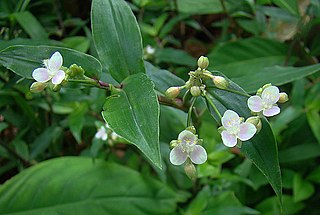
Cnidoscolus is a plant genus of the family Euphorbiaceae first described as a genus in 1827. The group is widespread across much of North and South America, including the West Indies.
Bernardia is a plant genus of the family Euphorbiaceae first described for modern science as a genus in 1754. It is native to North and South America, as well as the West Indies.

Dalechampia is a genus of plant of the family Euphorbiaceae and of the monogeneric subtribe Dalechampiinae. It is widespread across lowland tropical areas primarily in the Americas with smaller numbers of species in Africa, Madagascar, and southern Asia. Additional new species are still being described and several are very rare and at risk of extinction.

Manihot is a genus in the diverse milkspurge family, Euphorbiaceae. It was described as a genus in 1754.

Campomanesia is a genus in the family Myrtaceae described as a genus in 1794. It is native to South America and Trinidad.

Dyckia is a genus of plants in the family Bromeliaceae, subfamily Pitcairnioideae.

Oxypetalum is a genus of flowering plants in the family Apocynaceae, first described with this name in 1810. The genus is native to South America.

Handroanthus albus, the golden trumpet tree, is a tree with yellow flowers native to Argentina, Paraguay, Bolivia and the Cerrado of Brazil, where it is known as ipê-amarelo-da-serra.
Stomatanthes is a genus of African and South American plants in the tribe Eupatorieae within the family Asteraceae.

Austroeupatorium is a genus of plants native primarily to South America, including herbaceous perennials and shrubs. The native range is focused on eastern South America and extends as far north as Panama and Trinidad and as far west as Bolivia.
Scaphispatha is a genus of flowering plants in the family Araceae. It contains two species, S. gracilis and S. robusta. The genus was believed to be monotypic until 2003 when a new species, S. robusta was discovered by Eduardo Gomes Gonçalves in northern Brazil. The plant had been grown in cultivation for some years, but had always been assumed to be a Caladium until it flowered.
- Scaphispatha gracilisBrongn. ex Schott - Bolivia, Brazil
- Scaphispatha robustaE.G.Gonç. - Pará, Mato Grosso, Tocantins, Goiás

Hypenia is a genus of flowering plants in the mint family, Lamiaceae, first described as a genus in 1988. It is native to South America and southern Mexico.
- Hypenia aristulata(Epling) Harley - Goiás
- Hypenia brachystachys(Pohl ex Benth.) Harley - southern Brazil
- Hypenia calycina(Pohl ex Benth.) Harley - Brazil
- Hypenia concinna(Benth.) Harley - Tocantins
- Hypenia crispata(Pohl ex Benth.) Harley - Goiás
- Hypenia densiflora(Pohl ex Benth.) Harley - Brazil
- Hypenia durifolia(Epling) Harley - Brazil
- Hypenia gardneriana(Benth.) Harley - Brazil
- Hypenia glauca(A.St.-Hil. ex Benth.) Harley - Brazil, Paraguay
- Hypenia inelegans(Epling) Harley - Brazil
- Hypenia irregularis(Benth.) Harley - Brazil
- Hypenia macrantha(A.St.-Hil. ex Benth.) Harley - Brazil
- Hypenia macrosiphon(Briq.) Harley - Brazil, Paraguay, Bolivia
- Hypenia marifolia(Benth.) Harley - Brazil
- Hypenia micrantha(Benth.) Harley - Mato Grosso
- Hypenia paniculata(Benth.) Harley - Brazil
- Hypenia paradisi(Harley) Harley - Goiás
- Hypenia pauliana(Epling) Harley - Brazil
- Hypenia perplexa(Epling) Harley - Brazil
- Hypenia pruinosa(Pohl ex Benth.) Harley - Brazil
- Hypenia reticulata(Mart. ex Benth.) Harley - eastern Brazil
- Hypenia salzmannii(Benth.) Harley - Brazil, Guyana, Venezuela
- Hypenia simplex(A.St.-Hil. ex Benth.) Harley & J.F.B.Pastore - Brazil
- Hypenia subrosea(Harley) Harley - Goiás
- Hypenia violaceaMart.Gord. & S.Valencia - Guerrero, Oaxaca
Hyptidendron is a genus of plants in the family Lamiaceae, first described in 1849. The entire genus is endemic to South America.
- Hyptidendron amethystoides(Benth.) Harley - eastern Brazil
- Hyptidendron arboreum(Benth.) Harley - Guyana, Venezuela, Colombia, Ecuador, Peru, northwestern Brazil
- Hyptidendron arbusculum(Epling) Harley - Brazil
- Hyptidendron asperrimum(Spreng.) Harley - eastern Brazil
- Hyptidendron canum(Pohl ex Benth.) Harley - Brazil, Bolivia
- Hyptidendron caudatum(Epling & Játiva) Harley - Brazil
- Hyptidendron claussenii(Benth.) Harley - Minas Gerais
- Hyptidendron conspersum(Benth.) Harley - Bahia
- Hyptidendron dictiocalyx(Benth.) Harley - Goiás
- Hyptidendron eximium(Epling) Harley & J.F.B.Pastore - Mato Grosso
- Hyptidendron glutinosum(Benth.) Harley - Brazil, Bolivia
- Hyptidendron leucophyllum(Pohl ex Benth.) Harley - southern Brazil
- Hyptidendron rhabdocalyx(Mart. ex Benth.) Harley - southern Brazil
- Hyptidendron rondonicum(Harley) Harley - Brazil
- Hyptidendron unilaterale(Epling) Harley - southern Brazil
- Hyptidendron vauthieri(Briq.) Harley - southern Brazil
- Hyptidendron vepretorum(Mart. ex Benth.) Harley - Minas Gerais

Tripogandra is a genus of flowering plants in the spiderwort family, Commelinaceae. It is native to the Western Hemisphere from central Mexico and the West Indies south to Argentina.

Blepharodon is a genus of plant in the family Apocynaceae, first described as a genus in 1844. They are native primarily to South America, with one species extending into Central America and Mexico.
Nephradenia is a genus of plants in the family Apocynaceae, first described as a genus in 1844. They are native to South America.

Ditassa is a genus of plant in the family Apocynaceae, first described as a genus in 1810. It is native to South America.

Peplonia is a group of plants in the family Apocynaceae first described as a genus in 1844. The entire genus is endemic to Brazil.
- Peplonia asteria(Vell.) Fontella & E.A. Schwarz - Brazil
- Peplonia axillaris(Vell.) Fontella & Rapini - Brazil
- Peplonia bradeana(Fontella & E.A. Schwarz) Fontella & Rapini - Espírito Santo
- Peplonia hatschbachii(Fontella & de Lamare) Fontella & Rapini - Paraná
- Peplonia hilarianaE.Fourn. - Brazil
- Peplonia nitidaDecne. - Brazil
- Peplonia organensis(E.Fourn.) Fontella & Rapini - Brazil
- Peplonia riedelii(E.Fourn.) Fontella & Rapini - Rio de Janeiro

Vellozia is a plant genus in the family Velloziaceae, established in 1788.
Hemipogon is a genus of flowering plants in the family Apocynaceae, first described as a genus in 1844. It is native to South America.














